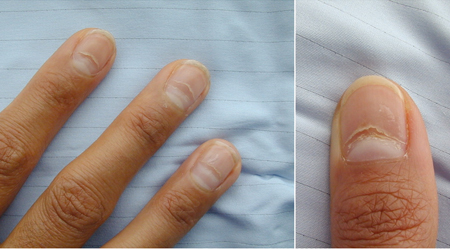History and exam
Key diagnostic factors
common
history of thyroid, parathyroid, or laryngeal surgery
Postsurgical hypoparathyroidism is the major etiology in adults.[1]
chronic alcoholism
malnutrition, malabsorption, diarrhea
muscle twitches, spasms, cramps
Muscle cramping, stiffness, and tetany may indicate chronic and/or mild hypocalcemia.
paresthesias, numbness, tingling
Intermittent or persistent paresthesia, numbness, or tingling may indicate acute or severe hypocalcemia. Chronic hypocalcemia may manifest as perioral and distal hand and foot paresthesias.
poor memory, slowed thinking
Can manifest with any degree of hypocalcemia.
uncommon
Chvostek sign
Ipsilateral contraction of facial muscles when facial nerve is tapped in front of the ear. Chvostek's sign: a video demonstration Opens in new window
convulsions
Usually generalized. May indicate acute or severe hypocalcemia.
irregular heart beat, tachycardia
Acute or severe hypocalcemia can cause prolonged QT interval on ECG, irregular heart beat, tachyarrhythmias, hypotension.[Figure caption and citation for the preceding image starts]: ECG demonstrating an atrial arrhythmia most likely to be atrial fibrillation in a patient with hypoparathyroidism and hypocalcemiaAdapted from Nijjer S, Ghosh AK, Dubrey SW. Hypocalcaemia, long QT interval and atrial arrhythmias. BMJ Case Reports 2010 [doi:10.1136/bcr.08.2009.2216]. Copyright © 2011 by the BMJ Publishing Group Ltd. [Citation ends].
Trousseau sign
Painful clasping response of fingers and hands when blood pressure cuff is inflated above systolic blood pressure. Trousseau's sign: video clip Opens in new window
Other diagnostic factors
common
anxiety
May be due to hyperventilation, which can worsen symptoms of hypocalcemia because alkalosis will lower serum fraction of ionized calcium.
dry hair, brittle nails
Chronic hypocalcemia.[Figure caption and citation for the preceding image starts]: Nail dystrophy due to hypocalcemiaNijjer S, Ghosh AK, Dubrey SW. Hypocalcaemia, long QT interval and atrial arrhythmias. BMJ Case Reports 2010 [doi:10.1136/bcr.08.2009.2216]. Copyright © 2011 by the BMJ Publishing Group Ltd. [Citation ends].
cataracts
Common after longstanding hypocalcemia in congenital forms of hypoparathyroidism.
uncommon
history of mucocutaneous candidiasis
Autoimmune polyendocrine syndrome type 1 (APS1) presents as mucocutaneous candidiasis in the first few years of life, followed by hypoparathyroidism and/or adrenal insufficiency, typically with onset in childhood.[12]
history of chronic transfusions in patients with thalassemia
Transfusional iron overload may occur in patients with thalassemia after many years of transfusions without adequate chelation therapy.
dyspnea
Can be due to wheezing, congestive heart failure, or laryngeal constriction; requires urgent evaluation and treatment.
laryngeal spasm
Can be caused by acute or severe hypocalcemia. It is a medical emergency that can be life-threatening if left untreated.
Risk factors
strong
thyroid surgery
Extensive surgery, such as total thyroidectomy for cancer, and lymph node dissection; prior surgery in the cervical area; less experienced surgeon.[21]
parathyroid surgery
Prior surgery in the cervical area, especially prior parathyroidectomy; less experienced surgeon.
Risk factors for transient hypoparathyroidism include: extent of parathyroid exploration; moderate hypercalcemia as an indication for parathyroid surgery (with the possibility of suppression of remaining normal gland[s] by prevailing hypercalcemia).[22]
hypomagnesemia
moderate and chronic maternal hypercalcemia (neonatal hypocalcemia)
Strong propensity to suppress neonatal parathyroid function.
weak
hereditary hemochromatosis
Hypoparathyroidism is a late manifestation after extensive iron deposition in tissues has occurred (e.g., liver, heart, pituitary gland).
transfusional iron overload in thalassemia
Seen after many years of transfusions without adequate chelation therapy.
Wilson disease
Copper deposition is a rare cause of hypoparathyroidism.
metastatic cancer
Hypoparathyroidism due to tumor infiltration or radiation therapy is a very rare manifestation.
Use of this content is subject to our disclaimer